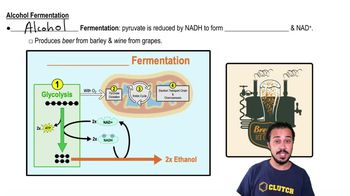Here are the essential concepts you must grasp in order to answer the question correctly.
Role of NADH in Metabolism
NADH is a crucial electron carrier in cellular metabolism, particularly in glycolysis and the citric acid cycle. It functions by accepting electrons during the oxidation of substrates, thus becoming reduced to NADH. This reduction is essential for the continuation of metabolic pathways, as NADH must be reoxidized to NAD+ to allow glycolysis to proceed and to maintain the flow of electrons through the electron transport chain.
Recommended video:
Introduction to Metabolism
Reoxidation of NADH in Respiration
In organisms that utilize respiration, NADH is reoxidized primarily through the electron transport chain located in the inner mitochondrial membrane. Here, NADH donates electrons, which are transferred through a series of protein complexes, ultimately leading to the reduction of oxygen to water. This process not only regenerates NAD+ but also drives ATP synthesis via oxidative phosphorylation, making it a highly efficient energy-producing mechanism.
Recommended video:
Reoxidation of NADH in Fermentation
In fermentation, NADH is reoxidized through substrate-level phosphorylation and the conversion of pyruvate into various end products, such as lactic acid or ethanol. This process allows for the regeneration of NAD+ without the need for an electron transport chain, enabling glycolysis to continue in anaerobic conditions. Fermentation is less efficient than respiration in terms of ATP yield but is vital for organisms that thrive in low-oxygen environments.
Recommended video:




